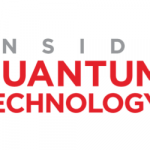Quantum News Briefs April 10: Key factors driving quantum computing into a new chapter; Archer Materials advances to wafer-scale quantum device fabrication; Humboldt-Universität zu BerlinResearchers make an important step towards the quantum internet using diamond nanostructures + MORE

Quantum News Briefs April 10: Key factors driving quantum computing into a new chapter; Archer Materials advances to wafer-scale quantum device fabrication; Humboldt-Universität zu BerlinResearchers make an important step towards the quantum internet using diamond nanostructures + MORE.
Key factors driving quantum computing into a new chapter
 Forbes contributor, Charlie Dai, VP of Research for Forester, discussed what factors are leading quantum computing into a “new chapter” in an April 7 article. Quantum News Briefs summarizes below.
Forbes contributor, Charlie Dai, VP of Research for Forester, discussed what factors are leading quantum computing into a “new chapter” in an April 7 article. Quantum News Briefs summarizes below.
- Vendors are making substantial progress in QC hardware and software innovation. Leading vendors such as IBM, Baidu, Google, D-Wave, IQM, IonQ, and Xanadu are making substantial progress with various modality approaches spanning superconductors, trapped ions, neutral atoms, nitrogen-vacancy centers, and photonics. IBM scaled its system from 27 qubits in 2019 to 433 qubits in 2022, providing rich developer support across kernel runtime, middleware, and applications. Baidu unveiled its quantum-as-a-service platform with quantum machine-learning (ML) development tools in 2020. It further announced an extensive QC portfolio in 2022, including Qian Shi, a quantum computer with a 10-qubit superconduct quantum chipset, and Liang Xi, a cloud-native quantum software platform with integrated quantum ML support.
- Technology ecosystem expansion is reaching a tipping point. IBM Quantum Network had only 40 members in 2019, but now over 210 Fortune 500 companies, universities, labs, and startups are pulling together toward the quantum future. Baidu’s Paddle Quantum has become an organic building block for quantum ML development as part of its PaddlePaddle. Baidu has not only formed a most active open source ecosystem for deep learning around this portfolio, serving over 5 million developers, but it has also published more than 600 open source AI models, and a dozen of them are quantum ML models for a range of business scenarios.
- Early business cases start to prove the differentiated commercial value of QC. We have already foreseen the strategic potential of QC for computation-intensive application scenarios commonly seen in the energy, pharmacy, transportation, logistics, materials science, and finance segments. E.ON became the first utilities company in Europe to work with IBM Quantum to implement quantum solutions. Baidu also provides quantum application models in its Paddle Quantum for a range of business scenarios, such as material simulation for chemistry, material surface quality inspection for manufacturing, protein folding for healthcare, and portfolio optimization for financial services.
- Decision-makers worldwide show interest in QC. According to Forrester’s Priorities Survey, 2022, 46% of business and technology decision-makers and influencers worldwide have some knowledge about emerging QC solutions, and 65% of them consider that QC will be important to their organizations. Click here to read Dai’s article in-entirety in Forbes.
Archer Materials advances to wafer-scale quantum device fabrication
 Archer Materials Limited has provided shareholders an update on the progress of its 12CQ chip development. During the past months the Company’s progress has involved the following:
Archer Materials Limited has provided shareholders an update on the progress of its 12CQ chip development. During the past months the Company’s progress has involved the following:- Development of a multi-scale wafer fabrication process for Archer’s quantum electronic devices.
- Commencing technical programs of low-temperature (cryogenic) characterisation of quantum electronic devices necessary for the development of qubit readout and control mechanisms in Archer’s chip-based quantum logic devices.
- Advances in optimising and validating the 12CQ qubit material coherence times.
- Development of an encapsulation method for the 12CQ qubit chips. Initial outcomes of the packaging development indicate cleanroom processing is compatible with standard semiconductor foundry methods while maintaining coherence times.
- Collaboration with researchers at EPFL, and since late 2022, the Company and EPFL have been developing second-generation, unique integrated chip designs for the potential complex spin manipulation of Archer’s qubit material.
- TSMC (the largest semiconductor foundry in the world) has accepted Archer as their customer after due diligence and screening. This permits Archer to access TSMC semiconductor fabrication process technologies, which include the most advanced technologies and also more mature process technologies
Commenting on Archer’s 12CQ chip development progress, Company CEO Dr Mohammad Choucair said: “Archer is making considerable progress across several fronts in 12CQ technology development. The Company’s technical achievements are providing a strong basis for pursuing external engagement with tier-one semiconductor companies. Read the complete announcement here on Globe Newswire.
Humboldt-Universität zu BerlinResearchers make an important step towards the quantum internet using diamond nanostructures
 Researchers in the “Integrated Quantum Photonics” group led by Prof. Dr. Tim Schröder at Humboldt-Universität zu Berlin have succeeded for the first time worldwide in generating and detecting photons with stable photon frequencies emitted from quantum light sources, or, more precisely, from nitrogen-vacancy defect centers in diamond nanostructures.
Researchers in the “Integrated Quantum Photonics” group led by Prof. Dr. Tim Schröder at Humboldt-Universität zu Berlin have succeeded for the first time worldwide in generating and detecting photons with stable photon frequencies emitted from quantum light sources, or, more precisely, from nitrogen-vacancy defect centers in diamond nanostructures.
This was enabled by carefully choosing the diamond material; sophisticated nanofabrication methods carried out at the Joint Lab Diamond Nanophotonics of the Ferdinand-Braun-Institut, Leibniz-Institut für Höchstfrequenztechnik; and specific experimental control protocols. By combining these methods, the noise of the electrons, which previously disturbed data transmission, can be significantly reduced, and the photons are emitted at a stable (communication) frequency.
In addition, the Berlin researchers show that the current communication rates between spatially separated quantum systems can prospectively be increased more than 1,000-fold with the help of the developed methods—an important step closer to a future quantum internet
To enable data transmission with feasible communication rates over long distances in a quantum network, all photons must be collected in optical fibers and transmitted without being lost. It must also be ensured that these photons all have the same color, i.e., the same frequency. Fulfilling these requirements has been impossible until now. Click here to read complete Phys.org coverage.Inside India’s first quantum computing-based telecom network
 India is getting its first quantum computing-based telecom network that will be operational in the national capital. Although still far away from public use, the link opens the doors for testing quantum-based networks in the real world. Developed by C-DoT (Centre for Development of Telematics), the link serves as a proof of concept, validating the system’s ability to function in real-world environments.
India is getting its first quantum computing-based telecom network that will be operational in the national capital. Although still far away from public use, the link opens the doors for testing quantum-based networks in the real world. Developed by C-DoT (Centre for Development of Telematics), the link serves as a proof of concept, validating the system’s ability to function in real-world environments.
The proof-of-concept aims to identify and address these challenges to ensure that the system performs optimally in real-world settings.
According to an official from C-DoT, deploying a system in the field exposes it to air pollutants, causing it to accumulate dirt and demand regular maintenance to prevent overheating. These issues provide valuable insights for designing better systems in the future.
The quantum internet will look similar to the Internet of Things (IoT) we know today. Similar to the sensors we use today to communicate between devices using the internet, quantum computers and quantum sensors will also be able to simulate reality with much wider applications.
Although this is certainly a positive step, it is important to acknowledge that India is still lagging in quantum by years. China, for instance, already launched the world’s first quantum network using satellite communication back in 2016, followed by the completion of a 2,000-kilometre-long optical fibre network for QKD in 2017. Moreover, other countries such as the United States, Japan, Australia, and several European nations have also made significant progress in this area. Therefore, India needs to accelerate its efforts and invest more resources to catch up. Click here to read the AIM article in-entirety.Sandra K. Helsel, Ph.D. has been researching and reporting on frontier technologies since 1990. She has her Ph.D. from the University of Arizona.
























